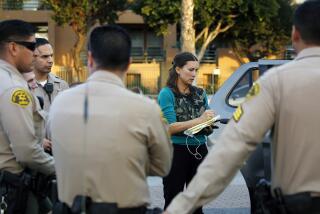THE O.J. SIMPSON MURDER TRIAL : When Called Into Court, Journalists Go Armed With Shield Law : Media: Simpson case isn’t the first local trial to provide a test of a provision that protects reporters’ sources and unpublished material.
- Share via
When KNBC reporter Tracie Savage left the hot seat at the O.J. Simpson murder trial Monday, more than a few court watchers may have been puzzled by the special legal protection she claimed in her testimony.
The answer can be found in a law that, ironically, had one of its biggest tests in another Los Angeles murder case that riveted the nation--the trial of Charles Manson a quarter of a century ago.
California’s so-called shield law, which protects journalists from revealing sources or unpublished material, became part of the state Constitution in 1980--eight years after a reporter went to jail for refusing to reveal his source for a sensational story on the Manson murder trial.
In 1970, while working for the now-defunct Los Angeles Herald Examiner, Bill Farr disclosed a purported plan by Manson to murder Hollywood celebrities such as Elizabeth Taylor and Frank Sinatra. The story, based on a confidential source, outraged the judge presiding over the Manson trial because he had forbidden attorneys, witnesses and anyone else associated with the case from discussing it outside the courtroom. When Farr invoked the shield law and refused to tell the judge who gave him the information, he was held in contempt and sent to jail.
After spending 46 days in jail, Farr was freed by an appellate court.
The shield law, enacted in 1935, has protected journalists from revealing their sources and unpublished material in countless civil and criminal trials.
In Monday’s case, reporter Savage invoked the law to avoid answering defense questions about her sources for a news story on DNA evidence. Judge Lance A. Ito, describing the issues as “complex” and requiring “careful consideration,” took the question of the shield law’s application under submission.
“The premise behind the law is that a reporter should not be used as a tool, by law enforcement in particular,” said Renee Nash, California Newspaper Publishers Assn. counsel. “And to protect the ability of news organizations to collect news, we have to protect news sources.”
In civil law cases, the state Supreme Court has made it clear that the privilege that protects reporters from being held in contempt is “absolute,” Nash said. “So no matter how much the [undisclosed] information is important to a case, reporters cannot be compelled to reveal it,” Nash said.
In a key 1990 ruling, the Supreme Court refused to order the Santa Barbara News Press to turn over unpublished photographs of a traffic accident. The photos had been subpoenaed by a motorist involved.
That same year, the state Supreme Court made an important ruling in the shield law’s application in criminal cases.
After his arrest by Long Beach police on suspicion of illegally carrying brass knuckles, Sean Patrick Delaney attempted to prove that he had been unlawfully searched by officers. That defense, Delaney’s attorney said, hinged on the testimony of a Los Angeles Times reporter and photographer who had been on an assignment with police when the arrest occurred.
After a seesaw battle in the lower courts, the Supreme Court narrowed the shield law’s protections, balancing the journalist’s right to confidentiality against the defendant’s 6th Amendment right to a fair trial. The ruling forced the journalists to testify.
In essence, the court said that a journalist could be compelled to identify a source--or divulge unpublished information--if defendants in a criminal trial could prove that doing so was important to their defense and that the information was not available from any other source.
In court papers and in Monday’s hearing, attorneys for Savage argued that those requirements had not been met because her story was based on confidential sources, not an eyewitness account.
But worry that the ruling might result in a flood of subpoenas to reporters never materialized, said Bill Niese, general counsel for The Times. The existing shield law is still sufficient to protect against unwarranted searches of journalists, said Niese.
And that, they said, is thanks to the 1980 constitutional amendment, championed by Farr and other journalists, that has withstood challenges from law enforcement and criminal defendants.
“What the Farr case did was galvanize the need to put [the shield law] in the [state] Constitution,” Niese said.
“Without the shield law, the news media would be, to use the cliche, sitting ducks,” Niese said. “If it were not for the shield law, reporters would be looked at like anyone else who comes upon an accident or comes upon a criminal act.”
So just as certain professionals can invoke a privilege to protect the sanctity of their discussions, journalists also have their protections.
“The law has its privileges to protect highly valued relationships: confessor-penitent, attorney-client, physician-patient,” said Terry Francke, executive director of the California First Amendment Coalition. “And in terms of journalism, the conclusion is that to get the truth out . . . sometimes requires a confidence.”
More to Read
The biggest entertainment stories
Get our big stories about Hollywood, film, television, music, arts, culture and more right in your inbox as soon as they publish.
You may occasionally receive promotional content from the Los Angeles Times.










